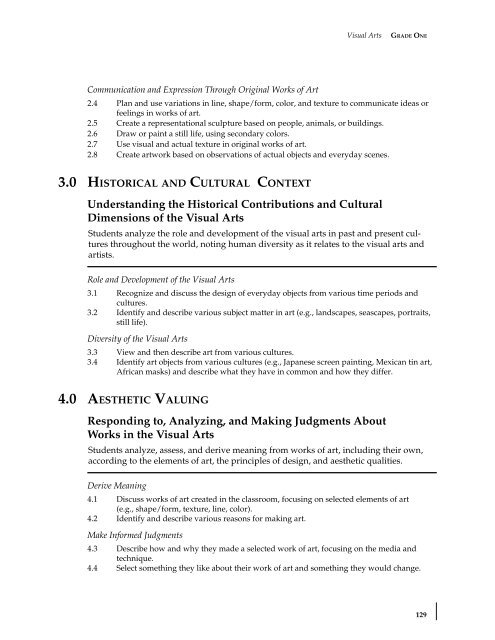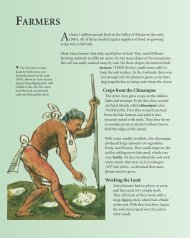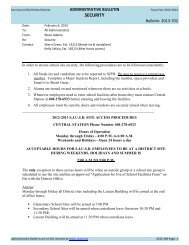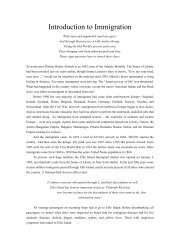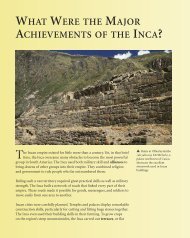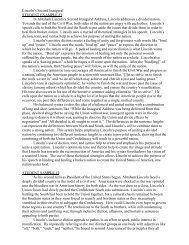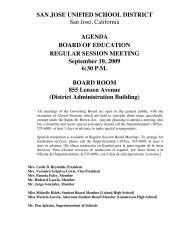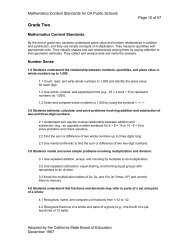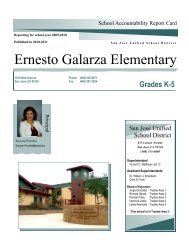Visual and Performing Arts Content Standards - California ...
Visual and Performing Arts Content Standards - California ...
Visual and Performing Arts Content Standards - California ...
Create successful ePaper yourself
Turn your PDF publications into a flip-book with our unique Google optimized e-Paper software.
<strong>Visual</strong> <strong>Arts</strong> GRADE ONE<br />
Communication <strong>and</strong> Expression Through Original Works of Art<br />
2.4 Plan <strong>and</strong> use variations in line, shape/form, color, <strong>and</strong> texture to communicate ideas or<br />
feelings in works of art.<br />
2.5 Create a representational sculpture based on people, animals, or buildings.<br />
2.6 Draw or paint a still life, using secondary colors.<br />
2.7 Use visual <strong>and</strong> actual texture in original works of art.<br />
2.8 Create artwork based on observations of actual objects <strong>and</strong> everyday scenes.<br />
3.0 HISTORICAL AND CULTURAL CONTEXT<br />
Underst<strong>and</strong>ing the Historical Contributions <strong>and</strong> Cultural<br />
Dimensions of the <strong>Visual</strong> <strong>Arts</strong><br />
Students analyze the role <strong>and</strong> development of the visual arts in past <strong>and</strong> present cultures<br />
throughout the world, noting human diversity as it relates to the visual arts <strong>and</strong><br />
artists.<br />
Role <strong>and</strong> Development of the <strong>Visual</strong> <strong>Arts</strong><br />
3.1Recognize <strong>and</strong> discuss the design of everyday objects from various time periods <strong>and</strong><br />
cultures.<br />
3.2 Identify <strong>and</strong> describe various subject matter in art (e.g., l<strong>and</strong>scapes, seascapes, portraits,<br />
still life).<br />
Diversity of the <strong>Visual</strong> <strong>Arts</strong><br />
3.3 View <strong>and</strong> then describe art from various cultures.<br />
3.4 Identify art objects from various cultures (e.g., Japanese screen painting, Mexican tin art,<br />
African masks) <strong>and</strong> describe what they have in common <strong>and</strong> how they differ.<br />
4.0 AESTHETIC VALUING<br />
Responding to, Analyzing, <strong>and</strong> Making Judgments About<br />
Works in the <strong>Visual</strong> <strong>Arts</strong><br />
Students analyze, assess, <strong>and</strong> derive meaning from works of art, including their own,<br />
according to the elements of art, the principles of design, <strong>and</strong> aesthetic qualities.<br />
Derive Meaning<br />
4.1Discuss works of art created in the classroom, focusing on selected elements of art<br />
(e.g., shape/form, texture, line, color).<br />
4.2 Identify <strong>and</strong> describe various reasons for making art.<br />
Make Informed Judgments<br />
4.3 Describe how <strong>and</strong> why they made a selected work of art, focusing on the media <strong>and</strong><br />
technique.<br />
4.4 Select something they like about their work of art <strong>and</strong> something they would change.<br />
129


